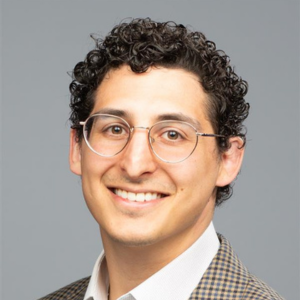Nearly one in 10 U.S. adults with one or more forms of substance use disorder (SUD) reportedly were hospitalized at least once over a one-year period, underscoring the opportunity to deliver hospital-based screening and treatments for SUD, according to new research by University of Colorado Department of Medicine faculty.
Prior studies show that most of these adults don’t receive SUD treatments in the hospital, and many don’t get such treatments outside the hospital, either, says Eden Bernstein, MD, assistant professor in the CU Division of Hospital Medicine and the study’s lead author.
“These findings highlight that this is a missed opportunity to help millions of people each year,” he says.
Bernstein’s CU Department of Medicine co-authors include Susan Calcaterra, MD, MPH, associate professor in the hospital medicine division; Gina Kruse, MD, associate professor in the CU Division of General Internal Medicine; and Vineet Chopra, MD, MSc, chair of the Department of Medicine.
Their research letter, “Prevalence of Hospitalizations Among a National Sample of U.S. Adults With Substance Use Disorders,” was published recently in the journal Annals of Internal Medicine.
Data from a national survey
The study, drawing on data from the 2022 National Survey on Drug Use and Health, identified 5.8 million adults with self-disclosed SUDs who reported they had been hospitalized in the previous year.
That figure was 9.7% of the 60 million U.S. adults identified in the survey as having SUD involving one or more of these substances: Alcohol, opioids, stimulants, cannabis, and tobacco. Tobacco-use disorder was defined as nicotine dependence as assessed by sets of questions.
Adults with SUDs were more likely to be hospitalized than adults without SUDs, although the survey data did not reveal how many of the hospitalizations were a result of SUDs.
Compared to adults with SUD who had not been hospitalized in the last year, the hospitalized group was more likely to be older and have more medical and psychiatric comorbid conditions. And while alcohol use disorder is far more prevalent in the general population than opioid use disorder, the latter group was more likely to have been hospitalized, the study found.
→ Key Takeaways from Largest-Ever Addiction Prevention and Treatment Implementation Study
Varying levels of treatment
“We were interested in how often patients with substance use disorders end up in the hospital,” says Bernstein, whose research focuses on describing care gaps in the treatment of alcohol and other substance use disorders. “There’s growing recognition that a lot of the time, these patients are not getting treatment for SUDs in other care settings, so the hospital might be an opportunity to engage them.”
He says hospital-based SUD programs “are growing around the country to address this. But we also know from prior work that most patients across the country who are hospitalized don’t receive evidence-based substance use and addiction treatment. Some hospitals have addiction treatment services that provide a lot of resources for these patients, but other hospitals don’t.”
In some cases, says Bernstein, the stigma surrounding substance use disorder “still plays a huge part in the way that this is viewed on a system level across the country, and is one of the major barriers for adopting some of these treatments.”
→ A Sharper Focus on Increased Cancer Risks from Drinking Alcohol
Vulnerable tobacco programs
Kruse, whose research focuses on tobacco cessation treatment in health care settings, says that hospitalized people “may be especially receptive to tobacco treatment services. It’s a time of forced abstinence because you’re not supposed to smoke when you’re in the hospital, and people may feel ready to make a change to improve their health.”
Unfortunately, Kruse adds, insurer reimbursement rates for tobacco programs are low, “and so these programs, even when they are available, are vulnerable. We’re lucky here because UCHealth does have inpatient and outpatient tobacco treatment services. But these programs need the investment of the hospital and the health care system.”
Calcaterra, who directs the Division of Hospital Medicine’s Addiction Medicine Consultation Service, says that rural hospitals are less likely to provide an addiction consult service, and also are less likely to treat opioid use disorder with medications.
On the other hand, she says, “academic hospitals tend to have these services because they’re more resource rich, and also do more research. So there have been gains made in treating substance use in the hospital, but these are largely limited to academic institutions.”
→ Why Children and Teens Should Avoid Nicotine Pouches Like Zyn
A lack of infrastructure
Calcaterra also cites a lack of “good linkage processes in place” at many hospitals to ensure that hospital-based SUD treatment is continued once patients are released.
“You can start a treatment in the hospital, but they need to continue that treatment when they leave,” she says. “And if there’s not a good referral network or someone to do that legwork, then a lot of clinicians don’t feel that there’s value in starting treatment in the hospital. The infrastructure doesn’t exist in a lot of hospitals specific to addiction treatment.”
Calcaterra notes that in her experience, clinicians’ interest in providing hospital-based addiction treatment when the hospitalization isn’t directly due to SUD often varies by the providers’ ages.
“Physicians who are a bit younger, more recently coming out of residency, see the value,” she says. “Many of them have more experience with medications treating specifically opioid use disorder, and probably alcohol use disorder, and so they’re more receptive to it. I think more established clinicians are less comfortable initiating medication treatment for SUD and often feel that it’s an outpatient issue, not a hospital issue, compared to younger clinicians.”
Screening varies
As for screening patients for substance use other than tobacco, Calcaterra says that the view of many hospitals is “there’s no point in universally screening for substances if you’re not going to provide an intervention, and most of these hospitals are not providing an intervention.”
However, screening for tobacco use is more common in hospitals than for some other substances, Kruse says. “People have advocated for screening for tobacco use as a vital sign, recognizing its importance and impact on people’s health in many ways. Screening for tobacco use and offering assistance to those interested in quitting was a 2012 Joint Commission performance measure, although an optional one.”
Bernstein says the new research may actually undercount how often people with SUDs are in the hospital because it relies on self-reporting and some patients may return multiple times in a year. The sample in the national survey also does not include unhoused people who do not reside in shelters, nor does it include incarcerated people.
Bottom line: “This highlights the opportunity to help a lot of patients that that we encounter if we expand hospital-based treatment for all of these substances,” he says.






